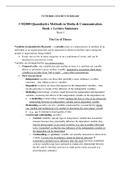Summary
CM2005 Summary - Quantitative Methods in Media & Communication @EUR
- Course
- Institution
This document contains a concise summary of all the material studied during the course Quantitative Methods in Media and Communication (CM2005), including book, articles, and lectures material. The summary also includes both theoretical and visual step-by-step instructions to conduct quantitative a...
[Show more]



